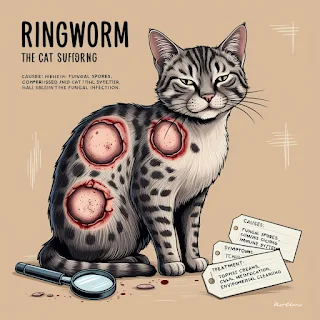Ringworm in Cats: Understanding the Fungal Infection
Ringworm in cats is a common fungal infection that affects the skin, hair, and nails of felines. Despite its name, ringworm is not caused by a worm but by a group of fungi known as dermatophytes. This contagious condition can spread not only among cats but also to humans and other animals. Recognizing the signs of ringworm early and seeking appropriate treatment is crucial for the health and well-being of your feline friend.
Symptoms of Ringworm: Identifying the Signs
Recognizing the symptoms of ringworm in cats is essential for early intervention. The most common signs include:
- Circular patches of hair loss with a red, scaly center
- Itching and scratching
- Broken or brittle hair
- Crusty or flaky skin
- Inflamed or reddened skin
- Dandruff-like scaling
If you notice any of these symptoms in your cat, it is important to consult with a veterinarian for a proper diagnosis and treatment plan.
Ringworm Cat Treatment: Effective Solutions for Feline Ringworm
Treating ringworm in cats involves a combination of topical and systemic therapies. The treatment plan may include:
- Topical antifungal creams or ointments applied directly to the affected areas
- Oral antifungal medications to combat the infection from within
- Medicated shampoos to help reduce fungal spores on the cat's coat
- Environmental decontamination to prevent reinfection
It is important to follow the veterinarian's instructions carefully and complete the full course of treatment to ensure the infection is fully eradicated.
Causes of Ringworm: Understanding the Source
Ringworm is caused by dermatophyte fungi, which thrive in warm and humid environments. Cats can contract ringworm through direct contact with an infected animal or by coming into contact with contaminated objects, such as bedding, grooming tools, or furniture. Kittens and cats with weakened immune systems are more susceptible to ringworm infections.
Cat Skin Infection: Recognizing and Addressing Ringworm
Cat skin infections, such as ringworm, can cause significant discomfort and health issues for your feline companion. It is important to monitor your cat's skin health regularly and seek veterinary care if you notice any abnormalities. Early detection and treatment of ringworm can prevent the spread of the infection and promote faster recovery.
Cat Ringworm Symptoms: What to Look For
Cat ringworm symptoms can vary, but some of the most common signs include:
- Hair loss in circular patterns
- Red, scaly skin lesions
- Itching and scratching
- Brittle or broken hair
- Crusty or flaky patches on the skin
Being vigilant about your cat's health and recognizing these symptoms early can help in providing timely treatment and care.
Cats Ringworm Treatment: Comprehensive Care for Infected Cats
The treatment of ringworm in cats requires a multifaceted approach. In addition to topical and oral medications, environmental cleaning is crucial to prevent reinfection. Regularly washing your cat's bedding, disinfecting grooming tools, and vacuuming your home can help eliminate fungal spores. Consistent follow-up visits to the veterinarian are also important to monitor your cat's progress and ensure the infection is completely cleared.
Ringworm in Kittens: Special Considerations for Young Cats
Ringworm in kittens can be particularly concerning due to their developing immune systems. Kittens are more vulnerable to infections and may require a more aggressive treatment approach. It is important to isolate infected kittens from other pets to prevent the spread of ringworm. Ensuring a clean and hygienic environment, along with prompt veterinary care, can help kittens recover quickly and reduce the risk of complications.




